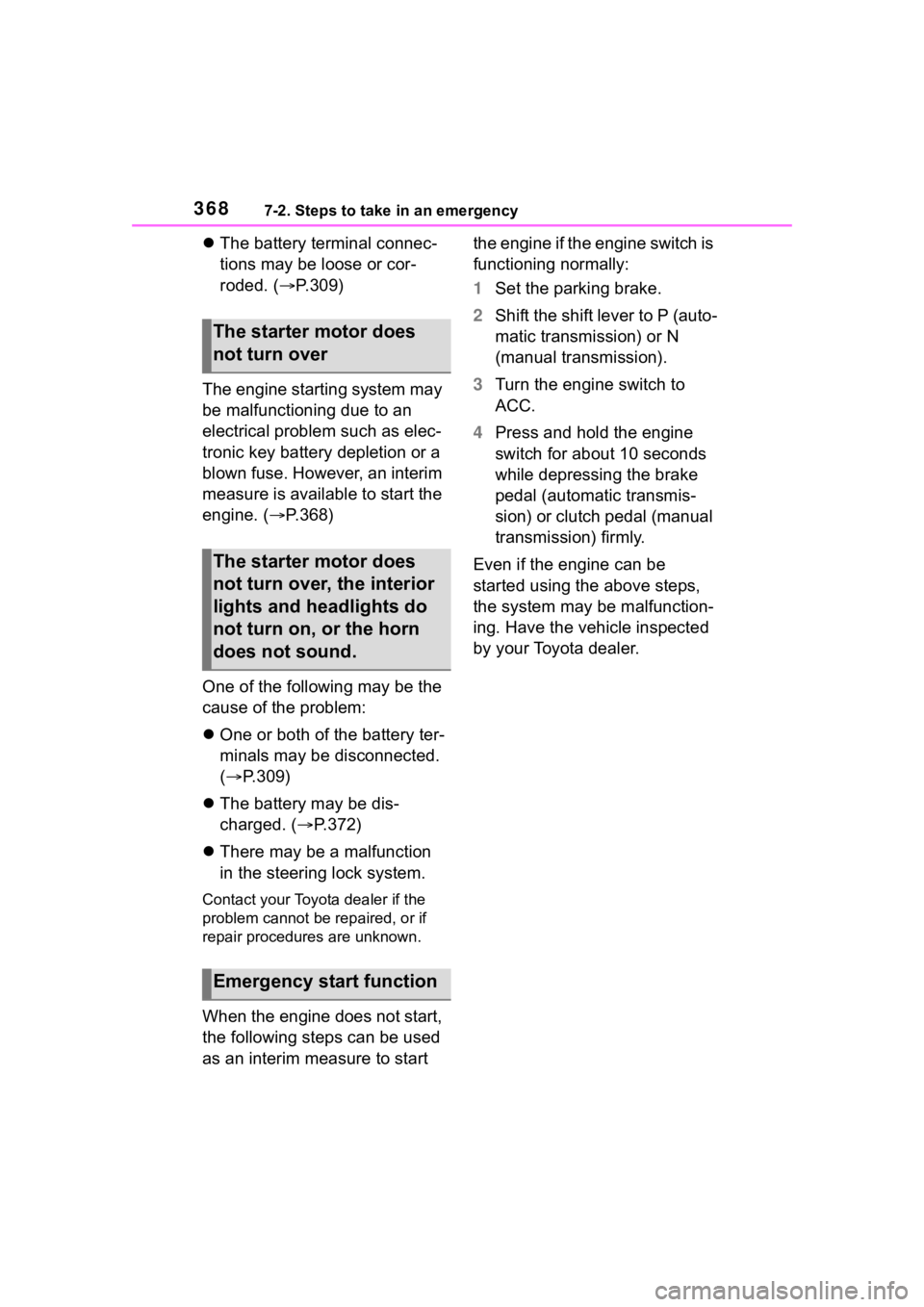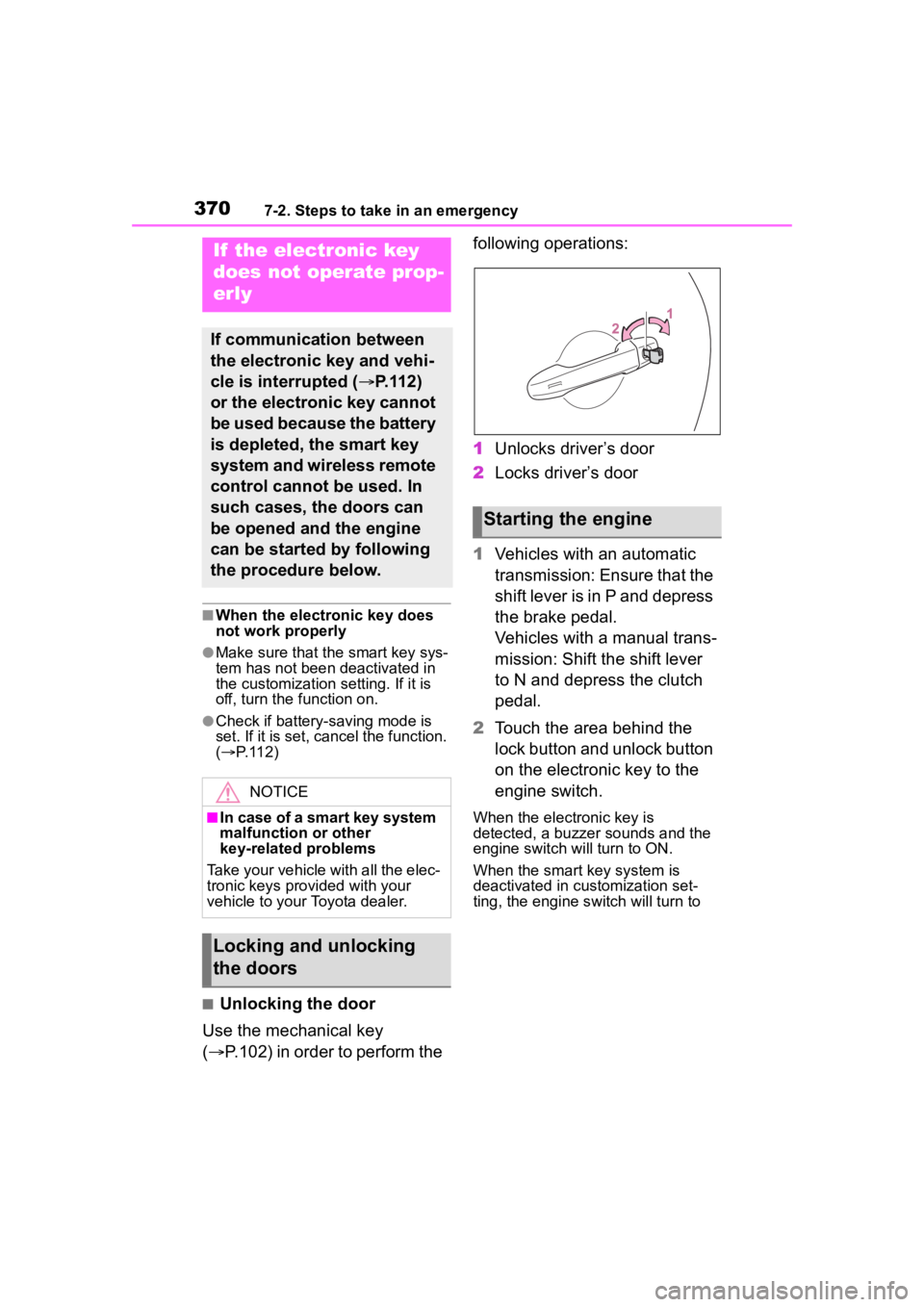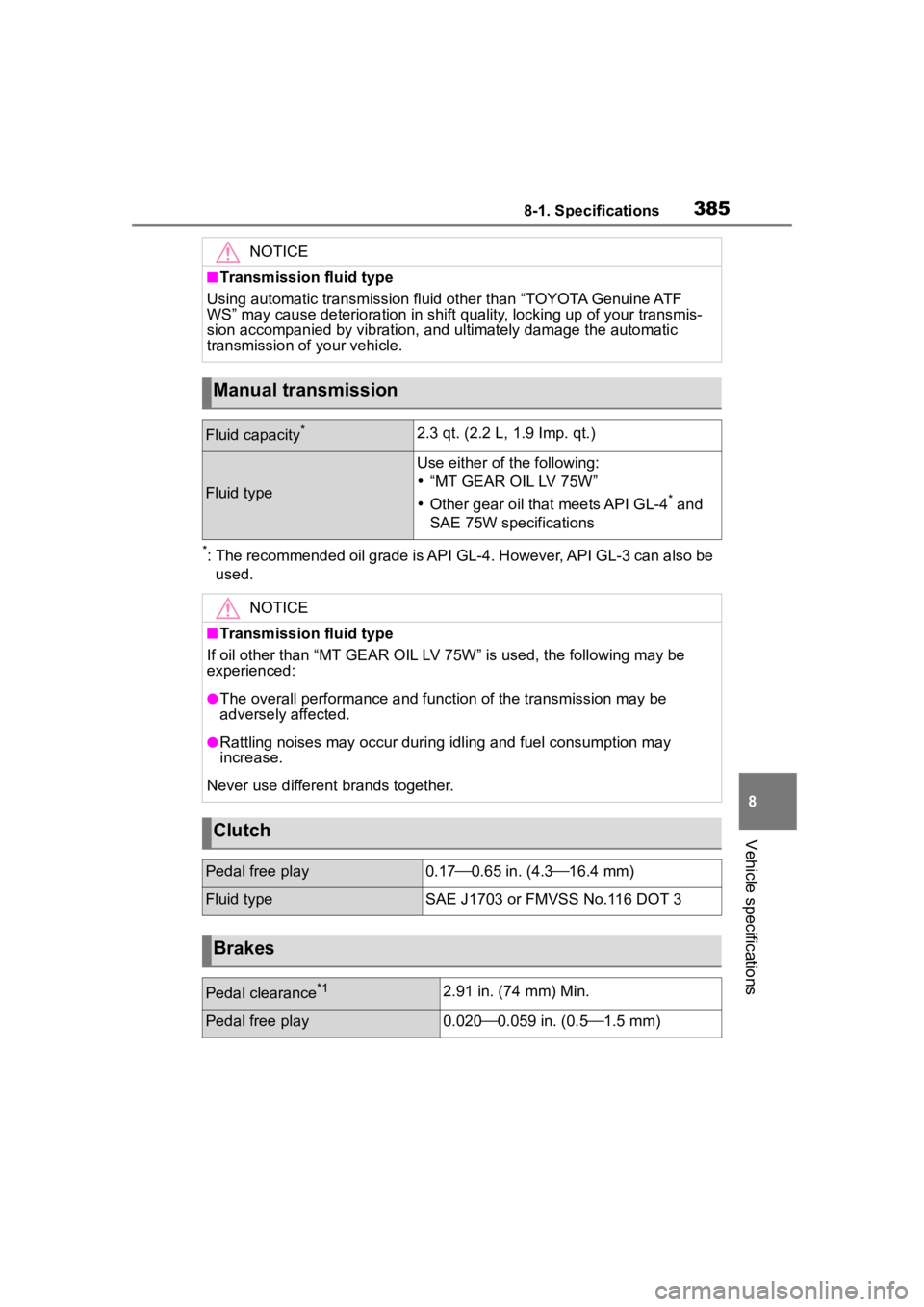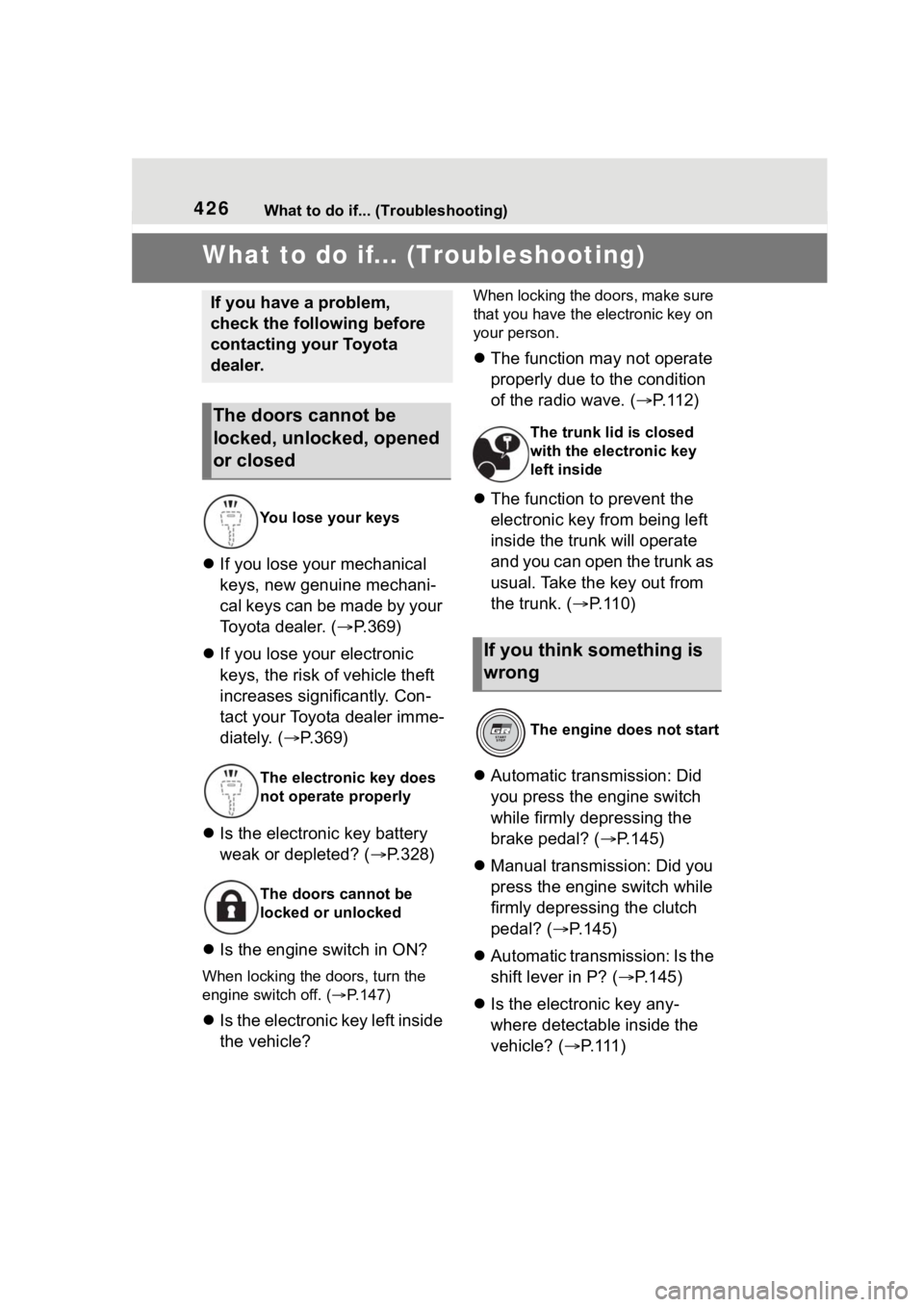Page 368 of 449

3687-2. Steps to take in an emergency
The battery terminal connec-
tions may be loose or cor-
roded. ( P.309)
The engine starting system may
be malfunctioning due to an
electrical problem such as elec-
tronic key battery depletion or a
blown fuse. However, an interim
measure is available to start the
engine. ( P.368)
One of the following may be the
cause of the problem:
One or both of the battery ter-
minals may be disconnected.
( P.309)
The battery may be dis-
charged. ( P.372)
There may be a malfunction
in the steering lock system.
Contact your Toyot a dealer if the
problem cannot be repaired, or if
repair procedures are unknown.
When the engine does not start,
the following steps can be used
as an interim measure to start the engine if the engine switch is
functioning normally:
1
Set the parking brake.
2 Shift the shift lever to P (auto-
matic transmission) or N
(manual transmission).
3 Turn the engine switch to
ACC.
4 Press and hold the engine
switch for about 10 seconds
while depressing the brake
pedal (automatic transmis-
sion) or clutch pedal (manual
transmission) firmly.
Even if the engine can be
started using the above steps,
the system may be malfunction-
ing. Have the vehicle inspected
by your Toyota dealer.
The starter motor does
not turn over
The starter motor does
not turn over, the interior
lights and headlights do
not turn on, or the horn
does not sound.
Emergency start function
Page 370 of 449

3707-2. Steps to take in an emergency
■When the electronic key does
not work properly
●Make sure that the smart key sys-
tem has not been deactivated in
the customization setting. If it is
off, turn the function on.
●Check if battery-saving mode is
set. If it is set, cancel the function.
( P.112)
■Unlocking the door
Use the mechanical key
( P.102) in order to perform the following operations:
1
Unlocks driver’s door
2 Locks driver’s door
1 Vehicles with an automatic
transmission: Ensure that the
shift lever is in P and depress
the brake pedal.
Vehicles with a manual trans-
mission: Shift the shift lever
to N and depress the clutch
pedal.
2 Touch the area behind the
lock button and unlock button
on the electronic key to the
engine switch.
When the electronic key is
detected, a buzzer sounds and the
engine switch will turn to ON.
When the smart key system is
deactivated in customization set-
ting, the engine switch will turn to
If the electronic key
does not operate prop-
erly
If communication between
the electronic key and vehi-
cle is interrupted ( P.112)
or the electronic key cannot
be used because the battery
is depleted, the smart key
system and wireless remote
control cannot be used. In
such cases, the doors can
be opened and the engine
can be started by following
the procedure below.
NOTICE
■In case of a smart key system
malfunction or other
key-related problems
Take your vehicle with all the elec-
tronic keys provided with your
vehicle to your Toyota dealer.
Locking and unlocking
the doors
Starting the engine
Page 371 of 449

3717-2. Steps to take in an emergency
7
When trouble arises
ACC.
3Firmly depress the brake
pedal (automatic transmis-
sion) or clutch pedal (manual
transmission) and check that
is shown on the
multi-information display.
4 Press the engine switch.
In the event that the engine still
cannot be started, contact your
Toyota dealer.
■Stopping the engine
Vehicles with an automatic trans-
mission: Shift the shift lever to P and
press the engine switch as you nor-
mally do when stopping the engine.
Vehicles with a manual transmis-
sion: Shift the shift lever to N and
press the engine switch as you nor-
mally do when stopping the engine.
■Electronic key battery
As the above proc edure is a tempo-
rary measure, it is recommended
that the electronic key battery be
replaced immediate ly when the bat-
tery is depleted. ( P.328)
■Alarm
Using the mechanical key to lock
the doors will not set the alarm sys-
tem.
If a door is unlocked using the
mechanical key when the alarm sys-
tem is set, the alarm may be trig-
gered.
■Changing engine switch modes
Release the brake pedal (automatic
transmission) or clutch pedal (man-
ual transmission) and press the
engine switch in step 3 above.
The engine does not start and
modes will be changed each time
the switch is pressed. ( P.147)
Page 377 of 449

3777-2. Steps to take in an emergency
7
When trouble arises
1Stop the engine. Set the
parking brake and shift the
shift lever to P (automatic
transmission) or N (manual
transmission).
2 Remove the mud, snow or
sand from around the rear
wheels.
3 Place wood, stones or some
other material under the rear
wheels to help provide trac-
tion.
4 Restart the engine.
5 Shift the shift lever to D or R
(automatic transmission) or 1
or R (manual transmission)
and release the parking
brake. Then, while exercising
caution, depress the acceler-
ator pedal.
■When it is difficult to free the
vehicle
Press the switch to turn off
TRAC.
If the vehicle becomes
stuck
Carry out the following pro-
cedures if the tires spin or
the vehicle becomes stuck
in mud, dirt or snow:
Recovering procedure
WARNING
■When attempting to free a
stuck vehicle
If you choose to push the vehicle
back and forth to free it, make
sure the surrounding area is clear
to avoid striking other vehicles,
objects or people. The vehicle
may also lunge forward or lunge
back suddenly as it becomes free.
Use extreme caution.
■When shifting the shift lever
(vehicles with an automatic
transmission)
Be careful not to shift the shift
lever with the accelerator pedal
depressed.
This may lead to unexpected
rapid acceleration of the vehicle
that may cause an accident
resulting in death o r serious injury.
NOTICE
■To avoid damaging the trans-
mission and other compo-
nents
●Avoid spinning the rear wheels
and depressing the accelerator
pedal more than necessary.
●If the vehicle remains stuck
even after these procedures are
performed, the vehicle may
require towing to be freed.
Page 383 of 449
3838-1. Specifications
8
Vehicle specifications
How to read oil container label:
The International Lubricant
Specification Advisory Commit-
tee (ILSAC) Certification Mark is
added to some oil containers to
help you select the oil you
should use.
Cooling system
Capacity
Vehicles with an automatic transmission
8.1 qt. (7.7 L, 6.8 Imp. qt.)
Vehicles with a manual transmission
7.8 qt. (7.4 L, 6.5 Imp. qt.)
Coolant type
Use either o f the following.
“TOYOTA Genuine 50/50 Pre-mixed Super
Long Life Coolant BLUE”
Similar high-quality et hylene glycol-based
non-silicate, non -amine, non-nitrite, and
non-borate coolant with long-life hybrid organic
acid technology
Do not use pla in water alone.
Ignition system (spark plug)
Make
GapDENSO ZXE27HBR8
0.031 in. (0.8 mm)
NOTICE
■Iridium-tipped spark plugs
Use only iridium-tipped spark pl ugs. Do not adjust gap when tun ing
engine.
Page 385 of 449

3858-1. Specifications
8
Vehicle specifications
*: The recommended oil grade is API GL-4. However, API GL-3 can also be
used.
NOTICE
■Transmission fluid type
Using automatic transmission fluid other than “TOYOTA Genuine A TF
WS” may cause deterioration in shift quality, locking up of your transmis-
sion accompanied by vibration, a nd ultimately damage the automatic
transmission of your vehicle.
Manual transmission
Fluid capacity*2.3 qt. (2.2 L, 1.9 Imp. qt.)
Fluid type
Use either of the following:
“MT GEAR OIL LV 75W”
Other gear oil that meets API GL-4
* and
SAE 75W specifications
NOTICE
■Transmission fluid type
If oil other than “MT GEAR OIL LV 75W” is used, the following m ay be
experienced:
●The overall performance and function of the transmission may be
adversely affected.
●Rattling noises may occur during idling and fuel consumption may
increase.
Never use different brands together.
Clutch
Pedal free play0.17 0.65 in. (4.3 16.4 mm)
Fluid typeSAE J1703 or FMVSS No.116 DOT 3
Brakes
Pedal clearance*12.91 in. (74 mm) Min.
Pedal free play0.0200.059 in. (0.51.5 mm)
Page 401 of 449
4018-2. Customization
8
Vehicle specifications
■Alarm (P.81)
■Gauges, meters and multi-information display ( P.84, 88, 93)
*1: For details about each function: P. 9 8
*2: The default setting varies according to country.
*3: Vehicles with manual transmission
*4: If equipped
FunctionDefault settingCustomized set-
ting
Operation when doors
are unlocked using the
mechanical key
OffOn——O
Function*1Default settingCustomized set-ting
LanguageEnglishFrenchO——Spanish
Units*2miles, MPH, MPGkm, km/h, l/100 kmOO—
Clock12H24HO——
Startup screenOnOffOO—
GSI (Gear Shift Indica-
tor)
*3OnOffOO—
REV. (Indicator)OffOnOO—
REV. (rpm)Off (2000 rpm)2000 rpm 7400
rpmOO—
REV. (Buzzer)OffOnOO—
Warning Volume*4MidMinOO—Max
Auto dimmer cancel3Off——O1 to 5
ABC
ABC
Page 426 of 449

426What to do if... (Troubleshooting)
1-1.What to do if... (Troubleshooting)What to do if... (Troubleshooting)
If you lose your mechanical
keys, new genuine mechani-
cal keys can be made by your
Toyota dealer. ( P.369)
If you lose your electronic
keys, the risk of vehicle theft
increases significantly. Con-
tact your Toyota dealer imme-
diately. ( P.369)
Is the electronic key battery
weak or depleted? ( P.328)
Is the engine switch in ON?
When locking the doors, turn the
engine switch off. ( P.147)
Is the electronic key left inside
the vehicle?
When locking the doors, make sure
that you have the electronic key on
your person.
The function may not operate
properly due to the condition
of the radio wave. ( P. 1 1 2 )
The function to prevent the
electronic key from being left
inside the trunk will operate
and you can open the trunk as
usual. Take the key out from
the trunk. ( P. 1 1 0 )
Automatic transmission: Did
you press the engine switch
while firmly depressing the
brake pedal? ( P.145)
Manual transmission: Did you
press the engine switch while
firmly depressing the clutch
pedal? ( P.145)
Automatic transmission: Is the
shift lever in P? ( P.145)
Is the electronic key any-
where detectable inside the
vehicle? ( P. 111 )
If you have a problem,
check the following before
contacting your Toyota
dealer.
The doors cannot be
locked, unlocked, opened
or closed
You lose your keys
The electronic key does
not operate properly
The doors cannot be
locked or unlocked
The trunk lid is closed
with the electronic key
left inside
If you think something is
wrong
The engine does not start